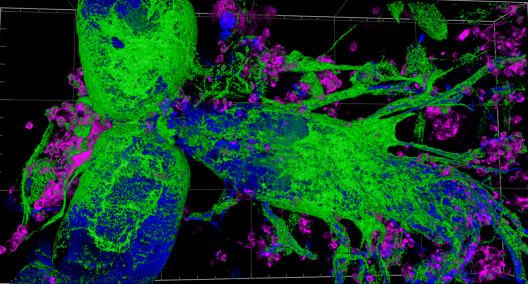Inflammation in the brain: My research on the fruit fly
(Research group Prof Christian Klämbt, Institute of Neuro- and Behavioural Biology)

What my research is about
I am a neurobiologist and have recently finished my PhD. In my research project, I looked at inflammation processes in the brain of fruit flies. I worked with genetically modified flies and created new genetic strains in which inflammation can be activated in the brain. In response to this inflammation, their immune cells – which are similar to our white blood cells – migrate into the brain. This novel inflammation model allows me to investigate how immune cells enter the brain and what they do in response to the inflammation.
Why my research is important
Many of us likely know or have known someone who has suffered from a disease such as multiple sclerosis, Alzheimer's or dementia. As yet, unfortunately, we do not fully understand these neurodegenerative diseases and they cannot be cured. However, researchers now know that inflammatory processes in the brain play a major role in all of these neurodegenerative diseases. We also know that when the brain is inflamed, immune cells from the blood sometimes migrate into the brain. Once there, the infiltrating immune cells either help resolve the inflammation or exacerbate it. This important process, which determines whether they will help or make the inflammation worse, and how the immune cells enter the brain in the first place have not yet been fully researched. To understand these events better, I developed the inflammation model in fruit flies.

What I found out in my research
It is known that the brain is well isolated from the rest of the body and protected from germs by the so-called blood-brain barrier. Recently, using my inflammation model in the fruit fly, I was able to show that during inflammation a very specific chain of signals is activated in the cells of the blood-brain barrier. This allows the immune cells to migrate into the brain. The signalling pathway induces the production of certain enzymes that break down part of the blood-brain barrier – more precisely, a layer of proteins known as the extracellular matrix. When this signalling pathway is blocked, immune cells can hardly enter the brain.
Can fruit flies really help in disease research?
Although fruit flies are so small and look very different from us, we have more in common with them than one might think. For example, just like humans, fruit flies have a well-protected brain and an innate immune system – and the brain and immune system interact with each other. However, since many of the processes in fruit flies are simpler than those in humans, we use them in our research to understand basic mechanisms. Thus, the knowledge gained from research with fruit flies can provide clues as to how similar processes might work in humans. I hope that, in the future, my model will contribute to answering fundamental questions about inflammatory processes in the human brain. This knowledge is essential for developing a better understanding of diseases like dementia as well as better treatments to combat and (hopefully, eventually even) cure them.
Links
- Publication about the inflammation model in the fruit fly: Winkler, B., Funke, D., Benmimoun, B., Spéder, P., Rey, S., Logan, M. A., & Klämbt, C. (2021). Brain inflammation triggers macrophage invasion across the blood-brain barrier in Drosophila during pupal stages. Science Advances, 7(44), 1–15. DOI: 10.1126/sciadv.abh0050
- Publication about the activation of a specific signalling pathway in the blood-brain barrier leading to the degeneration of the extracellular matrix of the fruit fly brain: Winkler B, Funke D, Klämbt C (2025) Macrophage invasion into the Drosophila brain requires JAK/STAT-dependent MMP activation in the blood–brain barrier. PLOS Biology 23(2): e3003035. DOI: 10.1371/journal.pbio.3003035
- Bente Winkler on Bluesky
- Research group of Prof Christian Klämbt at the University of Münster
This article is the result of a workshop on science communication for junior researchers. The participants learnt about the basic principles, quality criteria and different forms of science communication. Supported by 1:1 coaching sessions, they then created an article about their own research. The training course is a pilot project jointly developed and run by the Cells in Motion Interfaculty Centre and the Centre for Emerging Researchers at the University of Münster.

